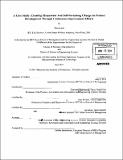A case study : creating momentum and self-sustaining change in product development through continuous improvement efforts
Author(s)
Lee, Steven (Steven SangHeon)
DownloadFull printable version (12.01Mb)
Other Contributors
Leaders for Global Operations Program.
Advisor
Deborah Nightingale and Roy Welsch.
Terms of use
Metadata
Show full item recordAbstract
Traditionally, in Raytheon's Integrated Defense System Product Development Engineering Group, lean initiatives have not been fully adopted. Though the lean tools are useful, the engineering group is looking for more effective deployment methods to implement lean. The conventional push approach is to have management communicate some strategic objective which generates a project. Historically, a useful lean tool is developed and introduced, but is under-utilized months later. We focused on implementing a push-pull hybrid approach. The purpose is to merge the strategic objectives with stakeholder values to generate a project that addresses needs from both ends. Organizations (such as Toyota) that are effective with change management typically spend 80 percent of their time and resources on people engagement and organizational architecture. The remaining 20 percent is spent on lean tool utilization. Raytheon emulated this model and generated initial people engagement. We discovered that successful change management embodies three factors: 1) Engaging Stakeholders 2) Engaging Leaders 3) and Ensuring Alignment of Organizational Architecture.
Description
Thesis (M.B.A.)--Massachusetts Institute of Technology, Sloan School of Management; and, (S.M.)--Massachusetts Institute of Technology, Engineering Systems Division; in conjunction with the Leaders for Global Operations Program at MIT, 2011. Cataloged from PDF version of thesis. Vita. Includes bibliographical references (p. 78-80).
Date issued
2011Department
Leaders for Global Operations Program at MIT; Massachusetts Institute of Technology. Engineering Systems Division; Sloan School of ManagementPublisher
Massachusetts Institute of Technology
Keywords
Sloan School of Management., Engineering Systems Division., Leaders for Global Operations Program.